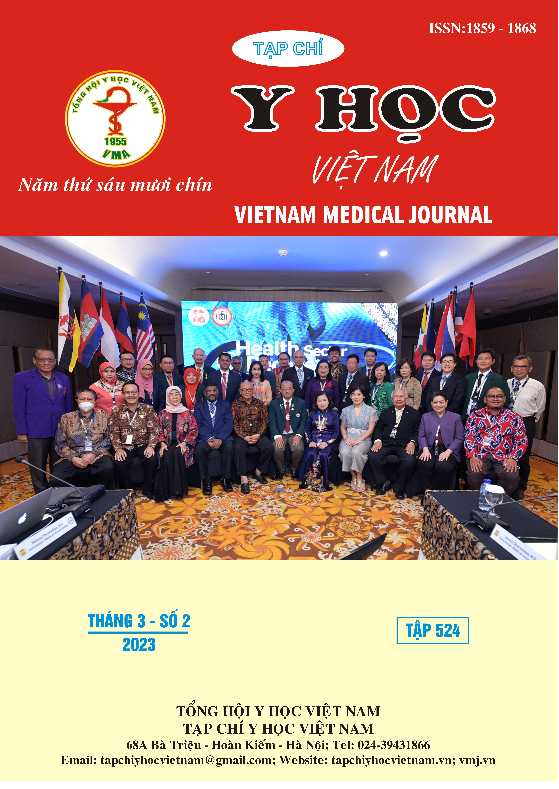RIGHT VENTRICULAR GLOBAL LONGTITUDINAL STRAIN ASSESSMENT BY 2D-SPECKLE TRECKING ECHOCARDIOGRAPHY IN BREAST CANCER PATIENTS TREATED AC-TH REGIMEN
Main Article Content
Abstract
Background: AC-TH regimen has brough not only valuable outcomes for breast cancer patients but also heart dysfunction. So far, reseaches have mainly focused on left ventricular dysfuctions, right ventricular dysfunctions need to be fulfilled. 2D specle trecking echocardiography, especially right ventricular global longtitudinal strain, is a helpful method to discover right ventricular dysfuction in early stage. So that, clinical implement will be improved. Methods: Follow-up observation containing six times 2D specle trecking echocardiography performances had been done through the AC-TH regimen treatment. The right ventricular global longtitudinal strain (RVGLS) and the right ventricular free wall strain were selected and assessed at those times. The relationship between RVGLS, RVFWS and chemotherapy-induced cardiotoxicity was also investigated. Results: 33 patients involving the research, in which the age median was 45,6 8,7, 100% female, 84,8% patients having no cardiovascular risk. RVGLS and RVFWS median was là -23,59 ± 3,44% và -25,83 ± 3,71%. It has gradually decreased at the following follow-up times, lowest at T2. The decrease value (delta Δ)of RVGLS và RVFWS is 5,75 ± 2,53 % and7,64 ± 3,14 %, respectively, and there was no relationship between RVGLS and RVFWS and chemotherapy-induce cardiotoxicity. Conclusion: Right ventricular global longtitudinual (RV GLS) and right ventricular free wall strain (RVFWS) decreased at the following follow-up times in breast cancer patients treated AC-TH regimen and there were no relations between them and chemotherapy-induce cardiotoxicity in those patients.
Article Details
Keywords
right ventricular global longtitudinal strain, right ventricular free wall strain, 2D specle trecking echocardiography, cardiotoxicity
References
2. Jelena Celutkien et al. (2020). Role of cardiovascular imaging in cancer patients receiving cardiotoxic therapies: a position statement on behalf of the Heart Failure Association (HFA), the European Association of Cardiovascular Imaging (EACVI) and the Cardio-Oncology Council of the European Society of Cardiology (ESC). European Journal of Heart Failure 22, 1504–1524
3. Russell S.D, Blackwell K.L, Lawrence J. et al. (2010). Independent adjudication of symptomatic heart failure with the use of doxorubicin and cyclophosphamide followed by trastuzumab adjuvant therapy: a combined review of cardiac data from the National Surgical Adjuvant breast and Bowel Project B-31 and the North Central Cancer Treatment Group N9831 clinical trials. J Am Soc Clin Oncol.. 28(21), 3416–3421
4. Luigi B Banado et al. (2020). How to do right ventricular strain. European Heart Journal - Cardiovascular Imaging, Volume 21, Issue 8, 825–827
5. Geris Mazzutti et al. (2021). Right Ventricular Function during Trastuzumab therapy for breast cancer. The International Journal of Cardiovascular Imaging.http://doi.org/10.21203/rs.3.rs721985/v1
6. Michal Laufer-Perl et al. (2022). Prevalence of right ventricular strain changes following anthracycline Therapy. Life. http://doi.org/1 0.3390/life120 20291
7. Anna Calleja et al. (2015). Right ventricular dysfunction in patients experiencing cardiotoxicity during breast cancer therapy. (2015). Journal of Oncology.http://doi.org/10.1155/2015/609194
8. Arciniegas Calle et al. (2018). Two-dimensional speckle tracking echocardiography predicts early subclinical cardiotoxicity associated with anthracycline-trastuzumab chemotherapy in patients with breast cancer. BMC Cancer. 18:1037.
9. Ferri et al. (2022). Right ventricular involvement in breast cancer patients undergoing chemotherapy.


